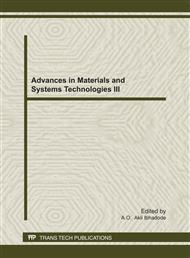p.301
p.311
p.319
p.327
p.335
p.343
p.353
p.359
p.367
Evaluation of Wood Properties of C. albidum Tree Grown in Akinyele Local Government Area of Ibadan, Nigeria in Relation to its Utilization
Abstract:
Fruit trees are hardly ever sought for their wood until recently. Fruit trees like C. albidum is now being used for structural and non structural purposes in city suburbs. This study investigated wood properties and few tree characteristics of C. albidum grown in Akinyele Local Government Area (ALGA), Ibadan, Oyo State, Nigeria. The aim was to mitigate the dearth of information on these features in relation to its utilization. Samples were collected from five emerging settlements in the study area while structured questionnaire and on-the-spot assessment were the instruments employed for data collection during survey stage. Physical appearance, moisture content (MC), green and oven-dry density, specific gravity of oven-dry samples, natural durability against termite, modulus of elasticity (MOE) and modulus of rupture (MOR) were determined via experimentation. Samples used for static bending strength were prepared in accordance with ASTM D 143 standard of 1991. The obtainable mean bole length, basal, middle and top girths were 4958mm, 1823mm, 1473mm and 1427mm respectively and the tree is moderately buttressed. The wood is brownish-white, crossed grain, coarse textured and fairly resistant to termite attack. Averagely on wet basis, MC and density are 52.46 %, 949 kg/m3 respectively and dry density is 739 kg/m3. Also MOR and MOE are respectively 1964N/mm2 and 1163.60N/mm2. The wood density compares with that of few commercially known tree species in N7-strength group thus preferred for non-structural than structural use especially when high bending stress is required.
Info:
Periodical:
Pages:
335-341
Citation:
Online since:
October 2011
Authors:
Price:
Сopyright:
© 2012 Trans Tech Publications Ltd. All Rights Reserved
Share:
Citation:


